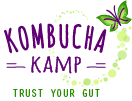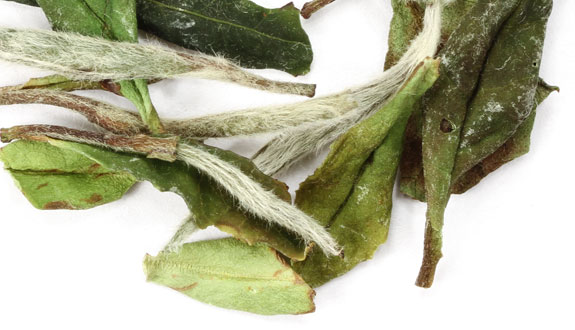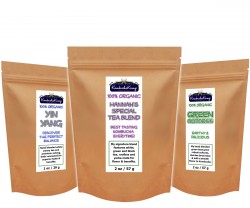How to Choose the Best Tea for Kombucha
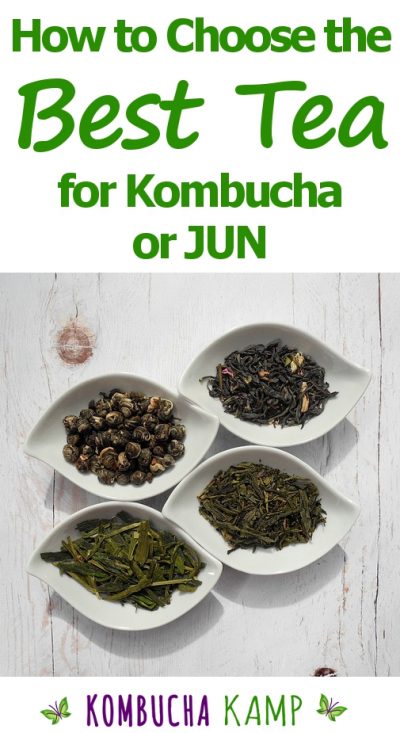 Tea is THE MOST POPULAR beverage in the world. Humans drink more tea than all other beverages combined including soft drinks, coffee and alcohol. So, it makes perfect sense that one of the chief ingredients of Kombucha is tea. But what is the best tea for Kombucha?
Tea is THE MOST POPULAR beverage in the world. Humans drink more tea than all other beverages combined including soft drinks, coffee and alcohol. So, it makes perfect sense that one of the chief ingredients of Kombucha is tea. But what is the best tea for Kombucha?
And even before that, what is tea? We hear about green tea, chamomile tea, peppermint tea, genmaicha (AMZ), rooibos, honeybush and Lipton’s tea to name a few. Perhaps any plant that we soak in hot water to create a beverage is tea? It may seem that way, and for day-to-day conversation there’s nothing wrong with that definition.
However, many “teas” do not contain what Kombucha needs to brew successfully, especially over time. Moreover, some plants may harm your culture and retard the formation of healthful elements in your homebrew.
Let’s take a closer look at the best types of tea for long term brewing of Kombucha.
What is tea?
The Latin name for the tea plant is Camellia sinensis. All types of tea – white, black, green, oolong, and post-fermented teas (such as pu-erh) etc. are derived from the same plant. The different types are primarily determined by how they are processed.
Traditionally, Kombucha has been brewed with black tea (known as “red tea” in China, named for the color of the resulting brewed liquid rather than the color of the leaves themselves). Research has shown that green tea produces the healthiest looking culture. The best tea for Kombucha is usually a blend, and the most common recipe for brewing Kombucha includes a combination of green & black tea.
Is Tea Healthy?
Research shows that tea has healing properties which Kombucha’s fermentation process helps to unlock. With Kombucha’s help, the polyphenols & anti-oxidants become more bio-available, which just means they are easier for your body to absorb. Once again, Kombucha works with nature’s own systems to improve their efficiency: Symbiosis!
Some health benefits attributed to tea are:
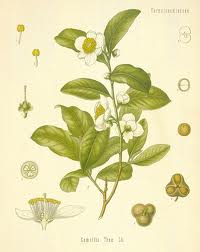
Camellia sinensis provides nitrogen to the SCOBY
- improves beneficial intestinal microflora
- provides immunity against intestinal disorders
- prevents tooth decay due to the presence of fluorine
- normalizes blood pressure
No wonder Kombucha has such a host of healing properties. It is made from a beverage that already has amazing health benefits. Then Kombucha makes it easier for the body to absorb those benefits through the magic of fermentation and a little colony of special bacteria and yeast, which end up producing a bunch of vitamins and enzymes that weren’t there before as well. Bonus!
Kombucha cultures love black tea and green tea and grow thick, healthy SCOBYs in either one. That said, black tea contains more fuel for the SCOBY to grow, so the cultures generally grow more quickly and more robustly.
**Bonus Definition – flush – tea is harvested 2 times per year. Each harvest is a flush. The leaves from the first flush in Spring have a different flavor and quality than those of the second flush in Summer. Some types of tea also have an Autumnal flush.
Why tea?
Tea contains several nutrients and compounds that feed the Kombucha culture including nitrogen, caffeine and theanine to name a few. Along with the sugar, tea is the main fuel source for the SCOBY. When you brew Kombucha with herbal infusions (also called tisanes), you may get a delicious, healthy fermented beverage, but over time, due to the lack of necessary nutrients, the culture will usually atrophy and eventually die.
That isn’t to say that brewers with experience shouldn’t try to make herbal “Kombucha.” But in order to protect the health of your culture it is recommended to either add some actual tea to your herbs or alternate batches with the tea plant to reinvigorate the culture. Beginners should stick to tea until you have enough large healthy cultures in your SCOBY Hotel to brew experimental batches.
White Tea
Common types of White Tea: Silver Needle Tea, White Peony Tea (白牡丹茶)
Blends featuring White Tea: Yin Yang, Hannah’s Special Tea Blend
White tea is harvested from the youngest, most delicate buds & leaves which are covered in fine white hairs and located at the top of the tea plant. Once picked, they are allowed to lightly wither in the sun and then are gently dried to prevent further enzymatic oxidation (meaning to turn darker from exposure to the air, kind of like an apple).
This gentle drying process protects the delicate flavor of the tea and ensures that the highest amount of anti-oxidants are present in the beverage. White tea produces a milder tasting Kombucha that is high in catechins.
Green Tea
Common types of Green Tea: Sencha, Bancha, Dragonwell (Longjing)
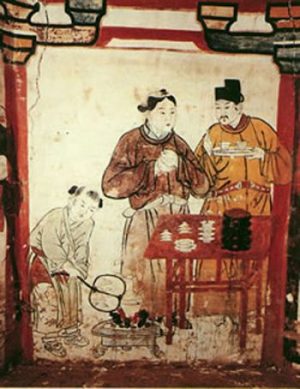
Tea was first discovered by the Chinese emperor Shennong in 2737 BCE
Blends featuring Green Tea: Green Goddess Blend, Hannah’s Special Tea Blend
Green tea is unfermented and delicately processed using sunlight, heating & rolling, which releases its essence. It is rich in catechin polyphenols, particularly epigallocatechin gallate (EGCG). Here are some of the healing properties attributed to EGCG:
- inhibits the growth of cancer cells without harming healthy tissue
- lowers LDL cholesterol levels
- naturally anti-bacterial
- boosts immunity
A special note about JUN: While the recipe for JUN Tea calls for green tea only, technically JUN could be brewed with any type of tea and would likely remain a healthy, vibrant brew. However, the flavor of JUN brewed with other types of tea is simply not as good. Although many have brewed JUN with other teas, most everyone returns to green tea for the best taste, so that is what we recommend.
Oolong Tea
With hundreds of varieties to choose from, we recommend the lesser known but most delicious Se Chung Special Oolong Tea.
Somewhere between the unfermented green tea and the fully fermented black tea is the “4th type” of tea. Partially fermented, oolongs come in hundreds of varieties based on the location of growing and the unlimited creativity of the producers. Oolong gives the tea grower and manufacturer the most opportunity to put their personality into the leaves. Differing regions will ferment the teas more or less, from only 10% all the way to nearly 100%, based on their long traditions for tea processing. This makes oolong many tea collector’s favorite!
Black Tea
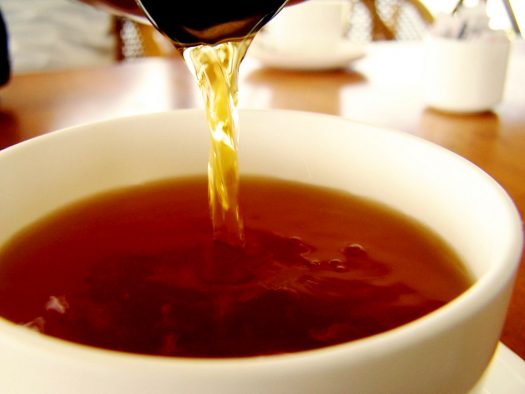
Black Tea leaves = “red tea” in Chinese
Common types of Black Tea: Assam Flowering Orange Pekoe, Ceylon, Darjeeling
Blends featuring Black Tea: Yin Yang, Hannah’s Special Tea Blend
*Note: “Orange Pekoe” listed on black tea labels does not indicate a flavor, instead this is used to indicate the size of the leaves. The term Orange Pekoe is now in use by some retailers to describe any generic type of medium grade and size black tea.
Black tea has a long history with Kombucha. The literal translation of the Chinese word for Kombucha – 紅茶菌 – is “red tea bacteria” (read more about the many names of Kombucha).
Though it was once thought that black tea didn’t contain nearly the benefits of green tea, it has been discovered that despite a longer oxidization process, it is very healthy.
Black tea is higher in purines which aid blood circulation and encourage warming properties. Some people blend in more black tea when brewing during the Winter to compensate for cooler temperatures. Women especially may experience poor circulation in their extremities and drinking Kombucha made with black tea can improve that condition.
****
All of these teas, in their seemingly unlimited varieties, have been shown to make healthy, delicious Kombucha and SCOBYs. Mix them and match them for a flavor combination you enjoy.
The Best Tea for Kombucha – 3 Blends to Choose From
Taking all of these factors into account, Hannah developed her own ideal mix of black tea, white tea, and green tea (plus a few dashes of selected brew-safe tisanes) for an ideal Kombucha brew and flavor. Not only that, it is absolutely delicious on its own. The reviews say it all, take a look at this tasty tea blend! CLICK HERE to visit Hannah’s Special Tea Blend
But not every brew should taste the same, and there are so many great tea options we always recommend mixing it up!
For a smooth, delicately flavored brew, a mix of white and oolong tea covers both sides of your personality, hence the name. CLICK HERE to visit the Yin Yang Tea Blend
Or for those that wish to have a green tea only option (perfect with any JUN brew as well), this 100% organic blend has lovely levels of flavor. CLICK HERE to visit the Green Goddess Tea Blend
Or you can sample all three by selecting the 3 Tea Sampler here.
However, there are some teas to avoid when making Kombucha.
Teas to Avoid
- Teas with flavorings teas such as Red Zinger or Chai: these often contain essential oils that may damage the culture. There are varying opinions about Earl Gray as it contains oil of bergamot but several people have brewed Kombucha with it successfully. You may not want to use it as your main tea but it adds nice flavor and body.
- Herbal infusions – as mentioned previously, these do not technically contain any Camellia sinensis. Some herbal infusions with high levels of volatile oils will retard the culture’s growth as they have a bactericidal effect (kill bacteria).
- Strongly smokey teas such as Lapsang Souchong. While they won’t technically damage the Kombucha, the flavor is a poor match in most cases.
Of course, now that we said don’t use these teas, everyone will want to use these teas and our inbox will fill with emails from people who have used them successfully. That’s one of the beautiful things about Kombucha: Experimentation!
Check out this post about exotic teas: Yerba Mate, Rooibos, Pu-erh (the secret “5th tea” type to some) and the wonderful world of Tea Tasting.
Quick Tea & Kombucha FAQ
How much tea should I use per gallon of sweet tea when making Kombucha?
We recommend 4-6 teaspoons per gallon of water, but that can be adjusted up or down depending on your preference.
CLICK HERE for the full Kombucha Recipe
Can I brew the tea more than once to make Kombucha?
While sometimes people steep tea multiple times for drinking, we do not recommend this with Kombucha. Use once and toss, or better yet add to your compost along with extra SCOBYs.
CLICK HERE for SCOBYs Other Uses
Can I use decaffeinated tea to make Kombucha instead?
Although a batch or two may be successful using decaf tea, over time the lack of caffeine will result in weaker cultures and brew. We recommend using tea with caffeine, though keep in mind that the amount present in the final brew is reduced by the fermentation process.
CLICK HERE for more on Kombucha & Caffeine
How do I make flavored Kombucha if I can’t add anything to the tea?
Add flavors in the second ferment stage, after removing the SCOBY and liquid for the next batch. This prevents the flavored elements from affecting the SCOBYs or the next brew, keeping the culture as strong as possible from batch to batch.
CLICK HERE for more about Flavoring Kombucha
Is fluoride in tea a concern?
There is a lot confusion around this issue, but the short answer is no, fluoride in tea is not a concern when making Kombucha. Longer answer: the naturally occurring fluorines present in tea leaves are Calcium Fluoride, a substance that your body needs. It is possible to have too much Calcium Fluoride in your diet or body, just as with any otherwise healthy thing. However, isolated cases of “fluoride poisoning” from drinking tea involve people consuming multiple gallons of super strong tea every day, not something that is ever recommended with Kombucha.
Can I use unusual teas like kukicha, genmaicha, matcha, pu-ehr, and others to make Kombucha?
You can brew anything you want with Kombucha, as long as you use an extra culture and liquid from your SCOBY Hotel! These teas fall into the “exotic” category when it comes to brewing the booch, so experiment to your heart’s content. But be aware for issues as strong flavors, hampered SCOBY growth, and even mold are more common with these plants.
CLICK HERE for advice on Brewing with Exotic Teas
What is the ideal type of tea for JUN?
The guidelines are to always brew JUN using green tea only. However, in truth, you can use any type of tea or even any tisane to make a batch of JUN, again using an extra culture to avoid contamination. Despite the options, most all brewers eventually return to using green tea with JUN, as it simply tastes the best.
